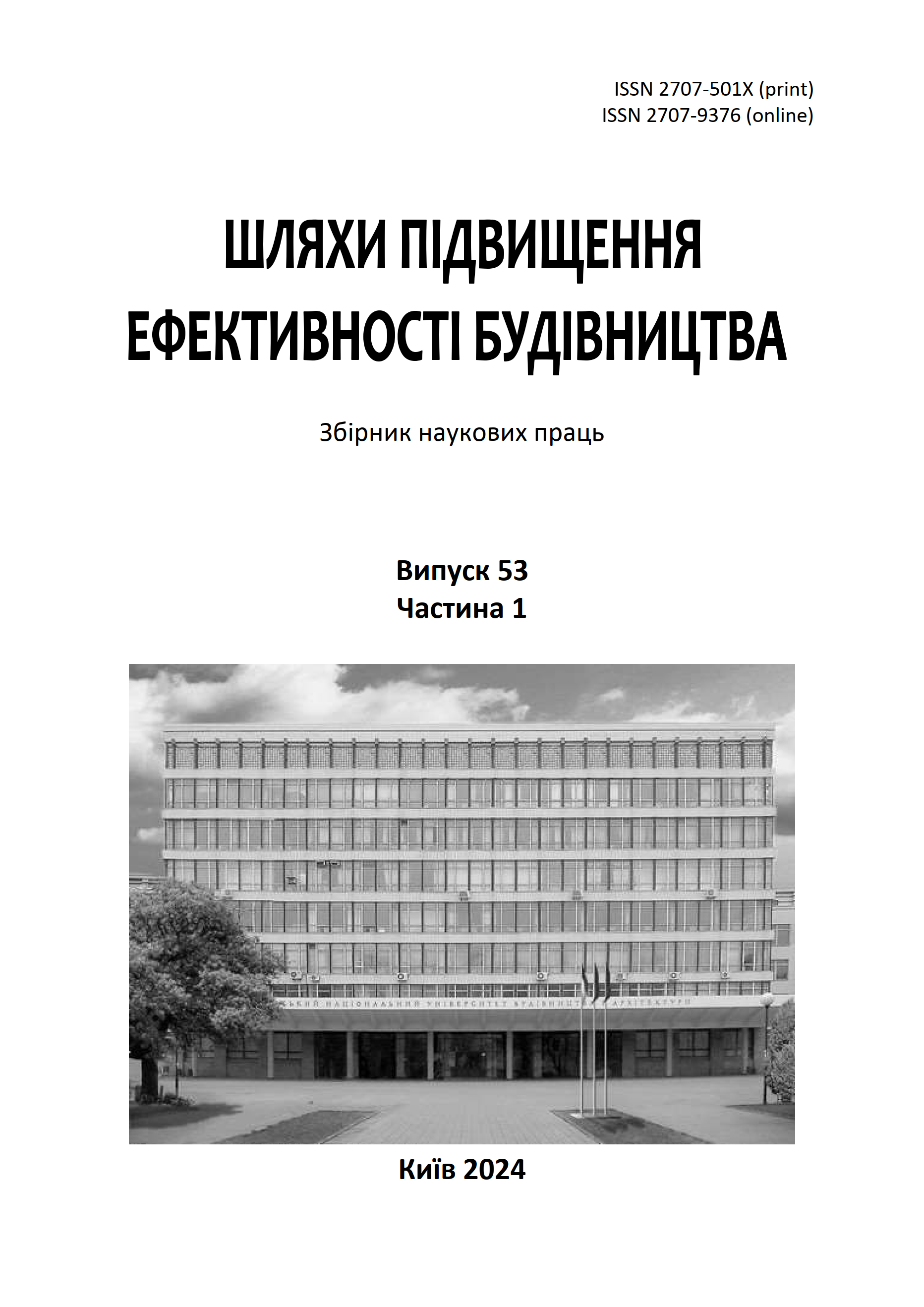Justification of the feasibility of using arrival reinforced concrete vaults
DOI:
https://doi.org/10.32347/2707-501x.2024.53(1).49-56Keywords:
reinforced concrete vaults, construction technology, concrete blend, labor intensity, standardization, efficiencyAbstract
The article discusses constructive and technological solutions for the use of reinforced concrete vaults. At this stage of society's development, in the difficult conditions of survival during hostilities, the issue of the safety of people's lives becomes urgent. The structural solution of buildings in the form of vaults is suitable for solving similar problems. The criterion for choosing a constructive solution is the reliability and functional volume of the building. The most reliable are reinforced concrete monolithic vaults made of modern materials. The most reliable is the arrow-shaped vault. The analysis of different forms of vault arches showed that unlike flat and full cylindrical vaults, pointed vaults have a more useful use of wall space at a height of up to 6.0 m, which makes the premises more functional. The criterion for choosing a technology is the speed of building the vault. The problematic issue of erecting monolithic reinforced concrete vaults remains the imperfect technology of arranging formwork, reinforcement and concreting. When concreting the curvilinear convex surface of the structure, the concrete slips. This article is dedicated to solving this problem. When switching to pointed vaults, it is not known how much the technology of performing the processes of formwork installation, reinforcement and concreting changes. The analysis of the existing technologies for the construction of monolithic vaults showed that the existing structural and technological solutions do not solve the problem of accelerating the construction speed. In order to prevent the process of slipping of concrete, the use of fiber is proposed. Additional studies are planned to study the effect of fiber concrete on sliding. The need for conducting research in the direction of improving constructive and technological solutions, improving the means of mechanization of the process, and in the direction of creating a system of normalization of labor costs for the processes of erecting pointed vaults has been identified.
References
Абизов В.А. Історія розвитку архітектурних-будівельних систем. Сучасні проблеми архітектури та містобудування. 2008. Вип. 19. С.123-127.
Носовський А.В. Об'єкт укриття. Енциклопедія Сучасної України. Редкол.: І.М. Дзюба, А І. Жуковський, М.Г. Железняк [та ін.]; НАН України, НТШ. К.: Інститут енциклопедичних досліджень НАН України, 2022. URL: https://esu.com.ua/article-75107
Свердлов В.Д., Сіянов О.І. Металеві циліндричні стержневі покриття: монографія. Вінниця: «УНІВЕРСУМ-Вінниця», 1999. 134 с.
Сіянов О.І. Металеві одношарові циліндричні стержневі покриття: конструювання та розрахунок: автореф. дис…канд. техн. наук: 05.23.01. Вінниця, 2002. 22 с.
Тонкачеєв В.Г. Визначення оптимальних конструктивних параметрів ребристо-кільцевих куполів покриття приміщень з корисною площею 200…500 м2. Містобудування та територіальне планування. 2016. Вип. 62. Ч. 1. С. 525–531.
ЕНиР Сб. Е4. Монтаж сборных и устройство монолитных железобетонных и бетонных конструкций. Вып. 1. Здания и промышленные сооружения. М: Стройиздат, 1987. 65 с.
КНУ Ресурсні елементні кошторисні норми на будівельні роботи. Бетонні та залізобетонні конструкції монолітні (Збірник 6). [Чинний від 2023-02-22]. URL: https://e-construction.gov.ua/files/upload/2022-11-05/68e480d0-673b-406b-a4ec-b0040bdbe9d9.pdf
Молодід О.С., Шандра О.Г. методи нормування процесів зведення монолітних будівельних конструкцій. Шляхи підвищення ефективності будівництва в умовах формування ринкових відносин. 2023. Вип. 52. Ч. 1. С. 55-61. DOI:10.32347/2707-501x.2023.52(1).55-61
Veenendaal D., Block Ph. Design process for prototype concrete shells using a hybrid cable-net and fabric formwork. Engineering Structures. 75 (2014). Р. 39-55. DOI:10.1016/j.engstruct.2014.05.036
Concrete Shells: Design Principles and Examples. URL: https://www.archdaily.com/895536/concrete-shells-design-principles-and-examples
Рухливість бетону – методи визначення і характеристики. URL: https://s-beton.com.ua/uk/podvizhnost-betona-metody-opredeleniya-i-harakteristiki.html
Кривенко П.В., Пушкарьова К.К., Барановський В.Б. та ін.. Будівельне матеріалознавство: підручник. К.: Видавництво Ліра-К, 2012. 624 с.
ДСТУ-Н Б В.2.6-203:2015. Настанова з виконання робіт при виготовленні та монтажі будівельних конструкцій. [Чинний від 2016-04-01]. URL: https://online.budstandart.com/ua/catalog/doc-page.html?id_doc=63372
Рекомендации по составлению карт трудовых процессов строительного производства. М.: СИ, 1983. 23 с.
Коломійчук Г.П., Майстренко О.Ф., Коломійчук В.Г. Ефективні залізобетонні оболонки і їх вибір для заданого плану будівлі. Сучасні технології та методи розрахунків у будівництві. 2017. Вип. 8. С. 111-118. URL: http://nbuv.gov.ua/UJRN/stmrb_2017_8_17
Downloads
Published
How to Cite
Issue
Section
License

This work is licensed under a Creative Commons Attribution 4.0 International License.
Authors who publish with this journal agree to the following terms:
- Authors retain copyright and grant the journal right of first publication with the work simultaneously licensed under a Creative Commons Attribution License that allows others to share the work with an acknowledgement of the work's authorship and initial publication in this journal.
- Authors are able to enter into separate, additional contractual arrangements for the non-exclusive distribution of the journal's published version of the work (e.g., post it to an institutional repository or publish it in a book), with an acknowledgement of its initial publication in this journal.
- Authors are permitted and encouraged to post their work online (e.g., in institutional repositories or on their website) prior to and during the submission process, as it can lead to productive exchanges, as well as earlier and greater citation of published work (See The Effect of Open Access).

